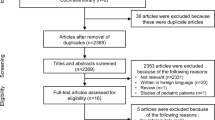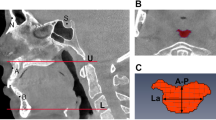Abstract
Purpose
Obstructive sleep apnea has been associated with chronic inflammation triggered by nocturnal hypoxemia. The neutrophil-to-lymphocyte ratio (NLR) is a measure of subclinical systemic inflammation. We hypothesize that NLR levels would improve as chronic inflammation diminishes in obstructive sleep apnea (OSA) patients treated with mandibular advancement devices (MADs).
Methods
We studied patients with OSA who were treated with MAD as a first-line treatment or because they could not tolerate CPAP. We obtained pre-treatment and post-treatment complete blood counts. NLR was calculated by dividing the number of neutrophils by the number of lymphocytes obtained from the CBCs. Patients with other conditions known to affect NLR were excluded from the study.
Results
We compared the values of NLR and oxygen desaturation index (ODI) before and after treatment with MAD in 22 patients who met inclusion criteria and completed the study protocol. There was a significant difference in NLR before and after treatment (p = 0.01). There was also a significant difference in the 3% ODI and 4% ODI before and after treatment with MAD (p = 0.014, 0.007), respectively. A subgroup analysis compared NLR in two groups of patients, the optimally treated and suboptimally treated. There was a significant decrease in the NLR in the optimally treated group (n = 10) (p < 0.01), whereas it did not change in the suboptimally treated group (n = 12) (p = 0.349).
Conclusion
The neutrophil-to-lymphocyte ratio may be useful in documenting improvement in inflammation for OSA patients treated with mandibular advancement devices. Our results specifically suggest that the NLR values are associated with the decrease in the ODI.





Similar content being viewed by others
References
Mohsenin V (2001) Gender differences in the expression of sleep-disordered breathing: role of upper airway dimensions. Chest 120(5):1442–1447. https://doi.org/10.1378/chest.120.5.1442
Peppard PE, Young T, Barnet JH et al (2013) Increased prevalence of sleep-disordered breathing in adults. Am J Epidemiol 177:1006–1014
Ramar K, Dort LC, Katz SG, Lettieri CJ, Harrod CG, Thomas SM, Chervin RD (2015) Clinical practice guideline for the treatment of obstructive sleep apnea and snoring with oral appliance therapy: an update for 2015. J Clin Sleep Med 11(7):773–827. https://doi.org/10.5664/jcsm.4858
Lavie L (2015) Oxidative stress in obstructive sleep apnea and intermittent hypoxia—revisited—the bad ugly and good: implications to the heart and brain. Sleep Med Rev 20:27–45. https://doi.org/10.1016/j.smrv.2014.07.003
Nadeem R, Molnar J, Madbouly EM et al (2013) Serum inflammatory markers in obstructive sleep apnea: a meta-analysis. J Clin Sleep Med 9:1003–1012
Zahorec R (2001) Ratio of neutrophil to lymphocyte counts—rapid and simple parameter of systemic inflammation and stress in critically ill. Bratisl Lek Listy 102(1):5–14
Sutherland K, Phillips CL, Davies A, Srinivasan VK, Dalci O, Yee BJ, Darendeliler MA, Grunstein RR, Cistulli PA (2014) CPAP pressure for prediction of oral appliance treatment response in obstructive sleep apnea. J Clin Sleep Med 10(9):943–949. https://doi.org/10.5664/jcsm.4020
Sutherland K, Takaya H, Qian J et al (2015) Oral appliance treatment response and polysomnographic phenotypes of obstructive sleep apnea. J Clin Sleep Med 11:861–868
Uygur F, Tanriverdi H, Aktop Z et al (2016) The neutrophil-to-lymphocyte ratio in patients with obstructive sleep apnoea syndrome and its relationship with cardiovascular disease. Heart Lung 45:121–125
Mehra R, Redline S (2008) Sleep apnea: a proinflammatory disorder that coaggregates with obesity. J Allergy Clin Immunol 121(5):1096–1102. https://doi.org/10.1016/j.jaci.2008.04.002
Yokoe T, Minoguchi K, Matsuo H et al (2003) Elevated levels of C-reactive protein and interleukin-6 in patients with obstructive sleep apnea syndrome are decreased by nasal continuous positive airway pressure. Circulation 107:1129–1134
Emin M, Wang G, Castagna F et al (2016) Increased internalization of complement inhibitor CD59 may contribute to endothelial inflammation in obstructive sleep apnea. Sci Transl Med 8:320ra321
Afari ME, Bhat T (2016) Neutrophil to lymphocyte ratio (NLR) and cardiovascular diseases: an update. Expert Rev Cardiovasc Ther 14(5):573–577. https://doi.org/10.1586/14779072.2016.1154788
Azab B, Chainani V, Shah N et al (2013) Neutrophil-lymphocyte ratio as a predictor of major adverse cardiac events among diabetic population: a 4-year follow-up study. Angiology 64:456–465
Bar-Ad V, Palmer J, Li L et al (2016) Neutrophil to lymphocyte ratio associated with prognosis of lung cancer. Clin Transl Oncol 19(6):711–717
Mcmillan DC, Morrison DS, Talwar D, Horgan PG, Proctor MJ (2011) Inflammation-based prognostic scores to predict outcome in patients with cancer. J Clin Oncol 29(15_suppl):e21154. https://doi.org/10.1200/jco.2011.29.15_suppl.e21154
Sawant AC, Adhikari P, Narra SR et al (2014) Neutrophil to lymphocyte ratio predicts short- and long-term mortality following revascularization therapy for ST elevation myocardial infarction. Cardiol J 21:500–508
Uthamalingam S, Patvardhan EA, Subramanian S, Ahmed W, Martin W, Daley M, Capodilupo R (2011) Utility of the neutrophil to lymphocyte ratio in predicting long-term outcomes in acute decompensated heart failure. Am J Cardiol 107(3):433–438. https://doi.org/10.1016/j.amjcard.2010.09.039
De Jager CP, Van Wijk PT, Mathoera RB et al (2010) Lymphocytopenia and neutrophil-lymphocyte count ratio predict bacteremia better than conventional infection markers in an emergency care unit. Crit Care 14(5):R192. https://doi.org/10.1186/cc9309
Altintas N, Cetinoglu E, Yuceege M et al (2015) Neutrophil-to-lymphocyte ratio in obstructive sleep apnea; a multi center, retrospective study. Eur Rev Med Pharmacol Sci 19:3234–3240
Oyama J, Nagatomo D, Yoshioka G et al (2016) The relationship between neutrophil to lymphocyte ratio, endothelial function, and severity in patients with obstructive sleep apnea. J Cardiol 67:295–302
Sunbul M, Sunbul EA, Kanar B, Yanartas O, Aydin S, Bacak A, Gulec H, Sari I (2015) The association of neutrophil to lymphocyte ratio with presence and severity of obstructive sleep apnea. Bratisl Lek Listy 116(11):654–658
Yenigun A, Karamanli H (2015) Investigation of the relationship between neutrophil-to-lymphocyte ratio and obstructive sleep apnoea syndrome. J Laryngol Otol 129(09):887–892. https://doi.org/10.1017/S0022215115001747
Korkmaz M, Korkmaz H, Kucuker F et al (2015) Evaluation of the association of sleep apnea-related systemic inflammation with CRP, ESR, and neutrophil-to-lymphocyte ratio. Med Sci Monit 21:477–481
Koseoglu S, Ozcan KM, Ikinciogullari A et al (2015) Relationship between neutrophil to lymphocyte ratio, platelet to lymphocyte ratio and obstructive sleep apnea syndrome. Adv Clin Exp Med 24(4):623–627. https://doi.org/10.17219/acem/58969
Baessler A, Nadeem R, Harvey M et al (2013) Treatment for sleep apnea by continuous positive airway pressure improves levels of inflammatory markers—a meta-analysis. J Inflamm (Lond) 10:13
Nizankowska-Jedrzejczyk A, Almeida FR, Lowe AA et al (2014) Modulation of inflammatory and hemostatic markers in obstructive sleep apnea patients treated with mandibular advancement splints: a parallel, controlled trial. J Clin Sleep Med 10(3):255–262. https://doi.org/10.5664/jcsm.3522
Funding
This research was supported by ResMed, SomnoMed, and Kettenbach LP.
Author information
Authors and Affiliations
Corresponding author
Ethics declarations
Conflict of interest
The authors declare that they have no conflict of interest.
Ethical approval
All procedures performed in studies involving human participants were in accordance with the ethical standards of the institutional research committee and with the 1964 Helsinki declaration and its later amendments or comparable ethical standards.
Informed consent
Written informed consent was obtained from all participants.
Additional information
Comment
At least during the last ten years there is increasing evidence from basic sciences that there are multiple correlations between normal and disturbed sleep (e.g. obstructive sleep apnea syndrome (OSAS) and metabolic, endocrinologic, immunolögic and inflammatory processes. Today, the clinical impact of these correlations is not fully understood. The manuscript of Al-Halawani et coworkers deals with the Impact of optimally versus non optimally treated OSAS on a marker of subclinical inflammation (Neutroph./lymphoc. ratio). If OSAS has a negative influence on this ratio, the question arises, whether sufficient treatment of OSAS has a positive influence.
It can be expected that similar studies will be submitted in the future.
Bernhard Schlueter
Datteln, Germany
Rights and permissions
About this article
Cite this article
Al-Halawani, M., Naik, S., Chan, M. et al. Neutrophil-to-lymphocyte ratio decreases in obstructive sleep apnea treated with mandibular advancement devices. Sleep Breath 22, 989–995 (2018). https://doi.org/10.1007/s11325-018-1635-5
Received:
Revised:
Accepted:
Published:
Issue Date:
DOI: https://doi.org/10.1007/s11325-018-1635-5




